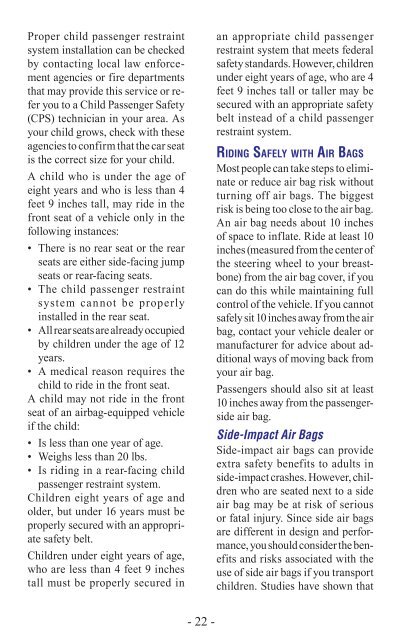dl600
dl600
dl600
Create successful ePaper yourself
Turn your PDF publications into a flip-book with our unique Google optimized e-Paper software.
Proper child passenger restraint<br />
system installation can be checked<br />
by contacting local law enforcement<br />
agencies or fire departments<br />
that may provide this service or refer<br />
you to a Child Passenger Safety<br />
(CPS) technician in your area. As<br />
your child grows, check with these<br />
agencies to confirm that the car seat<br />
is the correct size for your child.<br />
A child who is under the age of<br />
eight years and who is less than 4<br />
feet 9 inches tall, may ride in the<br />
front seat of a vehicle only in the<br />
following instances:<br />
• There is no rear seat or the rear<br />
seats are either side-facing jump<br />
seats or rear-facing seats.<br />
• The child passenger restraint<br />
system cannot be properly<br />
installed in the rear seat.<br />
• All rear seats are already occupied<br />
by children under the age of 12<br />
years.<br />
• A medical reason requires the<br />
child to ride in the front seat.<br />
A child may not ride in the front<br />
seat of an airbag-equipped vehicle<br />
if the child:<br />
• Is less than one year of age.<br />
• Weighs less than 20 lbs.<br />
• Is riding in a rear-facing child<br />
passenger restraint system.<br />
Children eight years of age and<br />
older, but under 16 years must be<br />
properly secured with an appropriate<br />
safety belt.<br />
Children under eight years of age,<br />
who are less than 4 feet 9 inches<br />
tall must be properly secured in<br />
an appropriate child passenger<br />
restraint system that meets federal<br />
safety standards. However, children<br />
under eight years of age, who are 4<br />
feet 9 inches tall or taller may be<br />
secured with an appropriate safety<br />
belt instead of a child passenger<br />
restraint system.<br />
Riding Safely with Air Bags<br />
Most people can take steps to eliminate<br />
or reduce air bag risk without<br />
turning off air bags. The biggest<br />
risk is being too close to the air bag.<br />
An air bag needs about 10 inches<br />
of space to inflate. Ride at least 10<br />
inches (measured from the center of<br />
the steering wheel to your breastbone)<br />
from the air bag cover, if you<br />
can do this while maintaining full<br />
control of the vehicle. If you cannot<br />
safely sit 10 inches away from the air<br />
bag, contact your vehicle dealer or<br />
manufacturer for advice about additional<br />
ways of moving back from<br />
your air bag.<br />
Passengers should also sit at least<br />
10 inches away from the passengerside<br />
air bag.<br />
Side-Impact Air Bags<br />
Side-impact air bags can provide<br />
extra safety benefits to adults in<br />
side-impact crashes. However, children<br />
who are seated next to a side<br />
air bag may be at risk of serious<br />
or fatal injury. Since side air bags<br />
are different in design and performance,<br />
you should consider the benefits<br />
and risks associated with the<br />
use of side air bags if you transport<br />
children. Studies have shown that<br />
- 22 -


